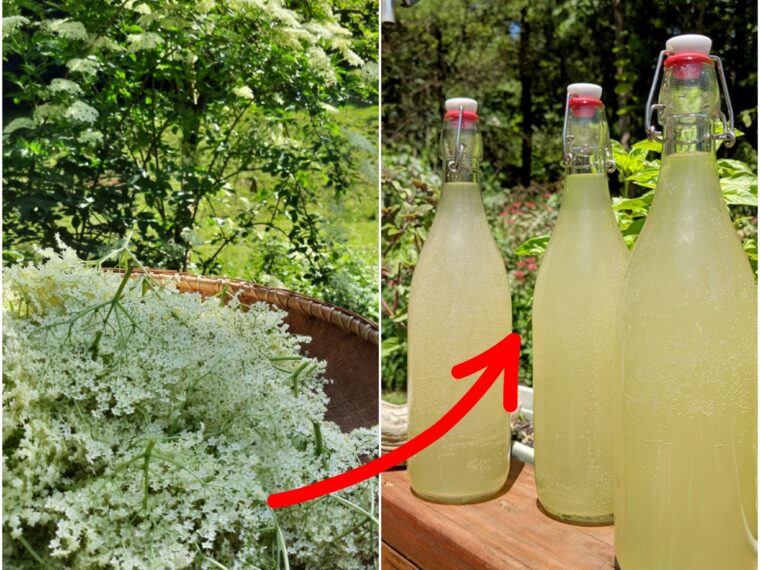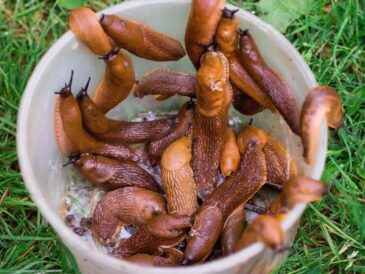Step 1: Harvesting the Elderflowers
- Pick elderflowers on a dry day when the flowers are fully open and fragrant.
- Avoid flowers near roadsides or treated with chemicals.
- Shake gently to remove bugs—don’t wash them (you’ll wash away natural yeasts).
Step 2: Making the Infusion
- Pour the cooled, boiled water into a clean fermenting bucket or large pot.
- Add the sugar and stir until completely dissolved.
- Add the elderflowers, sliced lemons (or zest and juice), and vinegar.
- Stir gently and cover with a clean cloth or muslin.
- Leave to steep for 24–48 hours at room temperature.
Step 3: Straining and Bottling
- After steeping, strain the liquid through a fine sieve or cheesecloth into another clean container.
- Optional: add champagne yeast if fermentation hasn’t started naturally.
- Pour into sterilized bottles—swing-top bottles or plastic soda bottles are best (they can withstand pressure).
- Leave some space at the top of each bottle.
Step 4: The Fermentation Process
- Leave the bottles at room temperature for 4–10 days.
- Check daily—once the bottles feel firm to the touch, indicating pressure from carbonation, move them to the fridge to slow fermentation.
Important Safety Tips
- Use strong bottles. Weak glass bottles can explode under pressure.
- Burp the bottles. If you’re using swing-top bottles, open them briefly every day or two to release pressure.
- Watch for signs of over-fermentation. If bottles become rock-hard or bulging, open them slowly over a sink.
How Long Does It Keep?
Homemade elderflower champagne is best enjoyed within 3–4 weeks. It’s freshest and fizziest in the first two weeks, and should be stored in the refrigerator to avoid over-fermentation.
Taste and Alcohol Content
The drink should be:
- Lightly fizzy
- Slightly sweet and citrusy
- Floral and refreshing
Alcohol content is usually around 1–3%, depending on fermentation time and sugar content. It’s very mild, but still considered an alcoholic beverage.
Variations to Try
- Add ginger slices for a spicy twist
- Mix with sparkling water for a lighter, non-alcoholic drink
- Blend with prosecco for a floral cocktail
Why Make Elderflower Champagne?
- It’s a zero-cost tradition (if you forage your own flowers)
- Connects you to seasonal rhythms
- Fun to make with kids (just skip fermentation for cordial)
- A unique, homemade gift
Troubleshooting Common Problems
It’s not fermenting!
- Make sure your water isn’t too hot—it could kill wild yeast.
- Add a pinch of champagne yeast to kickstart fermentation.
It’s too sweet.
- Let it ferment longer.
- Reduce sugar slightly next time.
Bottles are exploding.
- Too much sugar or fermentation time.
- Always refrigerate after desired carbonation is reached.
Conclusion
Elderflower champagne is more than just a drink—it’s a celebration of summer in a bottle. Whether you’re sipping it under the sun or sharing it at a garden party, this fizzy floral treat is sure to become a beloved yearly tradition. And the best part? It only takes a few ingredients, a bit of patience, and nature’s magic to make.
FAQs
1. Can I make elderflower champagne without yeast?
Yes! Wild yeast on the flowers is usually enough. Just don’t wash them.
2. Is elderflower champagne safe for kids?
The fermented version contains alcohol. For kids, make an elderflower cordial instead.
3. Can I use dried elderflowers?
Fresh flowers are best, but dried can work—use half the amount and expect less aroma.
4. How do I know it’s carbonated enough?
The bottles should feel firm, and you’ll hear a “pop” when opening.
5. Can I store it in the pantry?
Only before fermentation. Once pressure builds, bottles should be stored in the fridge.




